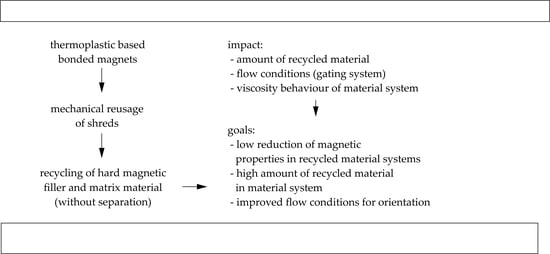Changes in Material Behavior according to the Amount of Recycled Magnetic Materials in Polymer-Bonded Magnets Based on Thermoplastics
Abstract
:1. Introduction
1.1. Magnetic Properties
1.2. Urgent Requirement of Recycling Strategies for Polymer-Bonded Magnets
1.3. Recycling Possibilities of Polymer-Bonded Magnets
2. Materials and Methods
2.1. Material
2.2. Fabrication of the Test Specimens
2.3. Characterization
2.3.1. Differential Scanning Calorimetry (DSC) following DIN EN ISO 11357
2.3.2. Thermogravimetric Analysis (TGA) following DIN EN ISO 11358
2.3.3. Particle Size Distribution
2.3.4. Determination of the Viscosity Behavior Based on a Rotational Viscometer
2.3.5. Magnetic Properties
2.3.6. Filler Orientation
3. Results and Discussion
3.1. Differential Scanning Calorimetry (DSC) following DIN EN ISO 11357
3.2. Thermogravimetric Analysis (TGA) following DIN EN ISO 11358
3.3. Particle Size Distribution
3.4. Determination of the Viscosity Behavior Based on a Rotational Viscometer
3.5. Magnetic Properties
3.6. Filler Orientation
4. Conclusions
- -
- A supportive effect due to the new material can only be reached with an amount of 50% or less recycled material.
- -
- The recycling process affects mainly the matrix material in terms of aging.
- -
- The possible magnetic properties and pole accuracy depend on the chosen amount of recycled material and the gating system.
- -
- The reduced magnetic properties in recycled materials are based on the lower orientation of the fillers.
- -
- The orientation of the fillers in recycled materials is highly influenced by the flow conditions rather than the outer magnetic field.
Author Contributions
Funding
Data Availability Statement
Conflicts of Interest
References
- Cassing, W.; Kuntze, K.; Ross, G. Dauermagnete: Mess- und Magnetisierungstechnik, 3rd ed.; Expert-Verlag: Renningen, Germany, 2018. [Google Scholar]
- Ivers-Tiffée, E.; Münch, W. Werkstoffe der Elektrotechnik, 10th ed.; B.G. Teubner Verlag: Wiesbaden, Germany, 2007. [Google Scholar]
- Grönefeld, M. Polymergebundene hartmagnetische Werkstoffe. In Magnetwerkstoffe für Technische Anwendungen; Haus der Technik e.V.: Essen, Germany, 2014. [Google Scholar]
- Hering, E.; Martin, R.; Stohrer, M. Physik für Ingenieure, 12th ed.; Springer Vieweg: Berlin, Germany, 2016. [Google Scholar]
- Schliesch, T. Kunststoffgebundene Dauermagnete: Werkstoffe, Auslegung und Prüftechnik. In Hochgefüllte Kunststoffe mit Definierten Magnetischen, Thermischen und Elektrischen Eigenschaften; Ehrenstein, G.W., Drummer, D., Eds.; Springer VDI Verlag: Düsseldorf, Germany, 2002; pp. 179–210. [Google Scholar]
- Johannaber, F.; Michaeli, W. Handbuch Spritzgießen, 2nd ed.; Carl Hanser Verlag: München, Germany, 2004. [Google Scholar]
- Krüger, G. Kunststoffgebundene und Metallische Magnete in Lösbaren Verbindungen; Carl Hanser Verlag: München, Germany, 2015. [Google Scholar]
- Drummer, D. Verarbeitung und Eigenschaften Kunststoffgebundener Dauermagnete. Ph.D. Thesis, Erlangen, Germany, 2004. [Google Scholar]
- Michalowsky, L.; Schneider, J. Magnettechnik: Grundlagen, Werkstoffe, Anwendungen, 3rd ed.; Vulkan Verlag: Essen, Germany, 2006. [Google Scholar]
- Ormerod, J.; Constantinides, S. Bonded permanent magnets: Current status and future opportunities (invited). J. Appl. Phys. 1997, 81, 4816–4820. [Google Scholar] [CrossRef]
- MS Schramberg GmbH & Co. KG, Umfassend. 2010. Available online: https://www.magnete.de/de.html (accessed on 26 October 2021).
- Gutfleisch, O.; Willard, M.A.; Brück, E.; Chen, C.H.; Sankar, S.G.; Liu, J.P. Magnetic materials and devices for the 21st century: Stronger, lighter, and more energy efficient. Adv. Mater. 2011, 23, 9506–9513. [Google Scholar] [CrossRef] [PubMed]
- Sprecher, B.; Kleijn, R.; Kramer, G.J. Recycling potential of neodymium: The case of computer hard disk drives. Environ. Sci. Technol. 2014, 48, 9506–9513. [Google Scholar] [CrossRef] [PubMed]
- Glöser-Chahoud, S.; Kühn, A.; Tercero Espinoza, L.A. Globale Verwendungsstrukturen der Magnetwerkstoffe Neodym und Dysprosium: Eine szenariobasierte Analyse der Auswirkung der Diffusion der Elektromobilität auf den Bedarf an Seltenen Erden. In Working Paper Sustainability and Innovation; Fraunhofer-Institut für System- und Innovationsforschung ISI: Karlsruhe, Germany, 2016. [Google Scholar]
- Ziegmann, G.; Kapustka, K. Recycling von Magnetischen Materialien aus Generatoren von Windkraftanlagen, Elektromotoren und Elektronikschrott: Kurztitel: IrmagMat; Abschlussbericht DBU, AZ: 34799/01; Projektträger, Technische Universität Clausthal Insitut für Polymerwerkstoffe und Kunststofftechnik: Clausthal-Zellerfeld, Germany, 2020. [Google Scholar]
- Rösel, U.; Drummer, D. Injection Molding of Multipolar Polymer-Bonded Magnets into Soft Magnetic Inserts for Rotors in Reluctance Motors. Magnetism 2021, 1, 3–21. [Google Scholar] [CrossRef]
- Rösel, U.; Drummer, D. Understanding the effect of material parameters on the processability of injection-molded thermosets-based bonded Magnets. Magnetism 2022, 2, 211–228. [Google Scholar] [CrossRef]
- Baur, E.; Brinkmann, S.; Osswald, T.; Rudolph, N.; Schmachtenberg, E. Saechtling Kunststoff Taschenbuch, 31st ed.; Carl Hanser Verlag: München, Germany, 2013. [Google Scholar]
- Dolgirev, J.; Kalter, M.; Urschel, S.; Funck, R.; Jung, J.; Schimmelpfennig, V. Resource-saving Cirulating Pump on basis of an Integrated Synchronous-Reluctance Drive System. In Proceedings of the IEEE 4th International Future Energy Electronics Conference (IFEEC), Singapore, 25–28 November 2019; pp. 1–7. [Google Scholar]
- Buchert, M.; Manhart, A.; Suttler, J. Untersuchung zu Seltenen Erden: Permanentmagnete im Industriellen Einsatz in Baden-Württemberg; Öko-Institut eV: Breisgau, Germany, 2014. [Google Scholar]
- Rast, U.; Blank, R.; Buchert, M.; Elwert, T.; Finsterwalder, F.; Hörnig, G.; Klier, T.; Langkau, S.; Marscheider-Weidermann, S.; Müller, J.-O.; et al. Recycling von Komponenten und Strategische Metallen aus Elektrischen Fahrantrieben: Kennwort: MORE (Motor Recycling); FKZ: Munchen, Germany, 2014. [Google Scholar]
- Meyer, F. Recycling von Neodym aus NdFeB-Magneten in Elektroaltgeräten: Potential und Mögliche Recyclingverfahren; Bachelorarbeit: Hamburg, Germany, 2021. [Google Scholar]
- Rösel, U.; Drummer, D. Possibilities in Recycling Magnetic Materials in Applications of Polymer-Bonded Magnets. Magnetism 2022, 2, 251–270. [Google Scholar] [CrossRef]
- DIN EN ISO 11357-1:2016; Kunststoffe—Dynamische Differenz Thermoanalyse (DSC)—Teil 1: Allgemeine Grundlagen. Deutsches Institut für Normung e. V.: Berlin, Germany, 2016.
- Ehrenstein, G.W.; Riedel, G.; Trawiel, P. Praxis der Thermischen Analyse von Kunststoffen, 2nd ed.; Carl Hanser Verlag: München, Germany, 2003. [Google Scholar]
- DIN EN ISO 11358-1:2022; Thermogravimetrie (TG) von Polymeren—Teil 1: Allgemeine Grundsätze. Deutsches Institut für Normung e. V.: Berlin, Germany, 2022.
- Netzsch-Gerätebau GmbH, Creep (Rheology). 2023. Available online: https://analyzing-testing.netzsch.com/en/training-know-how/glossary/creep-rheology (accessed on 12 September 2023).
- Kurth, K. Zum Spritzgießen Polorientierter Kunststoffgebundener Dauermagnete. Ph.D. Thesis, Lehrstuhl für Kunststofftechnik, Erlangen, Germany, 2019. [Google Scholar]
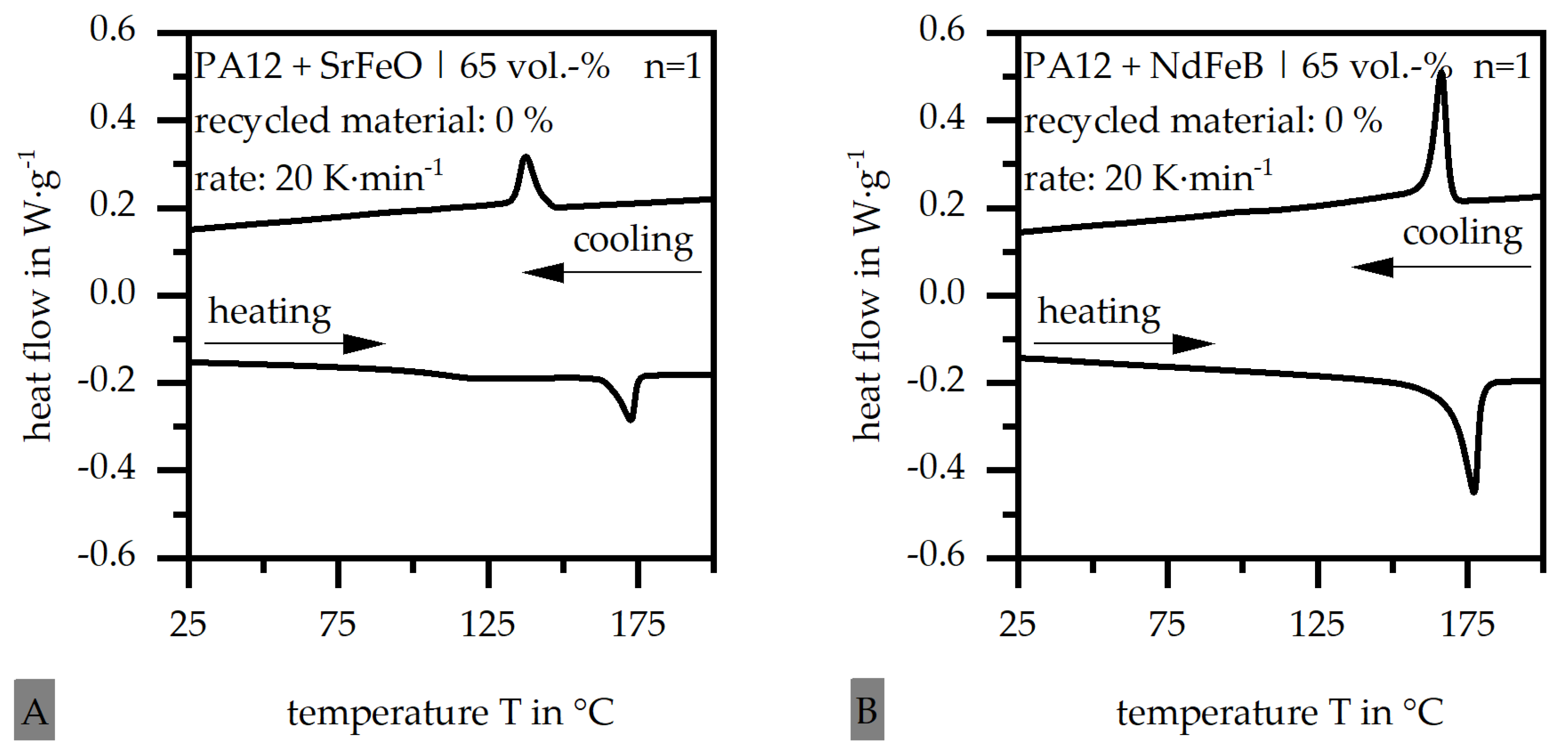

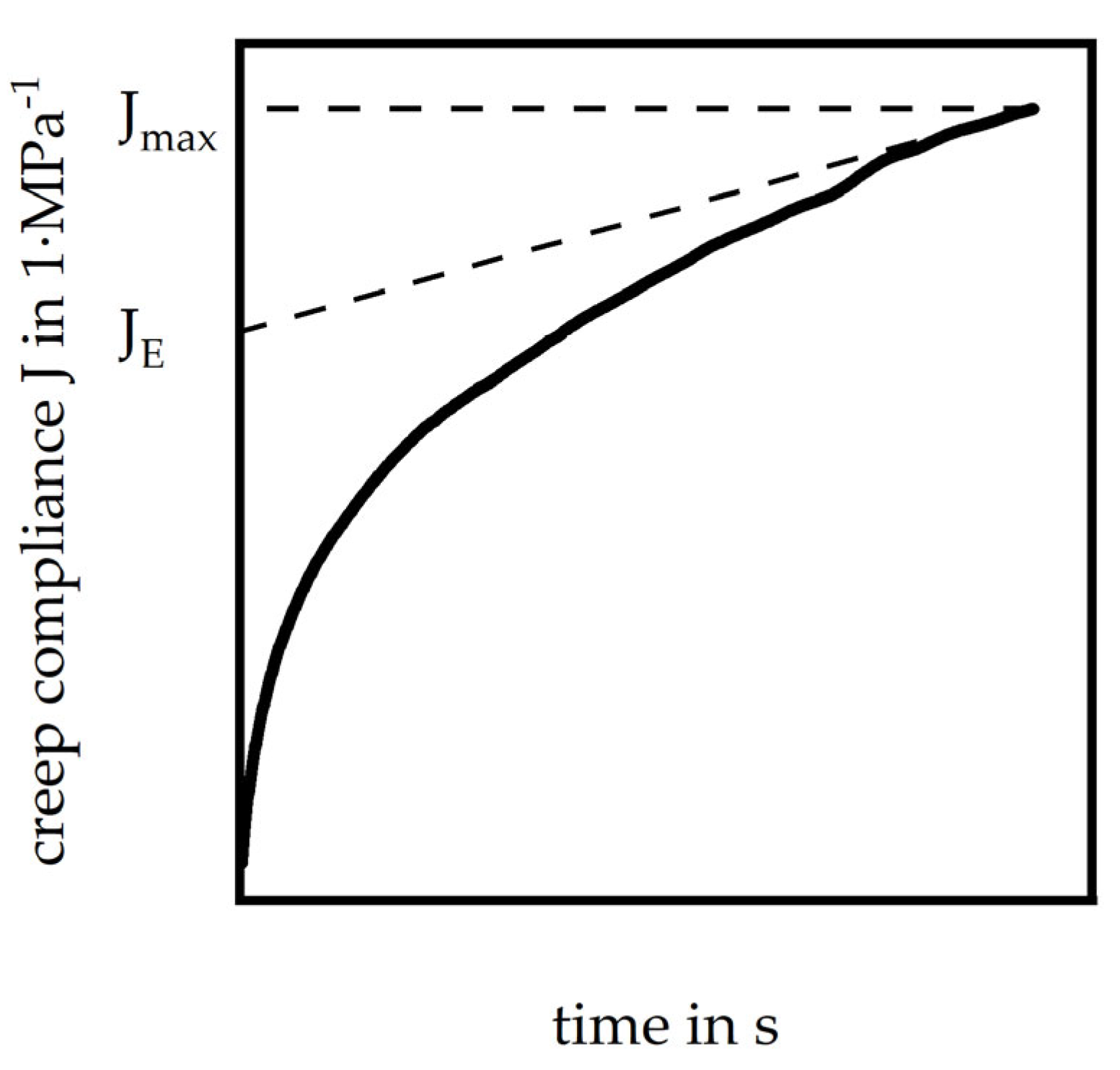
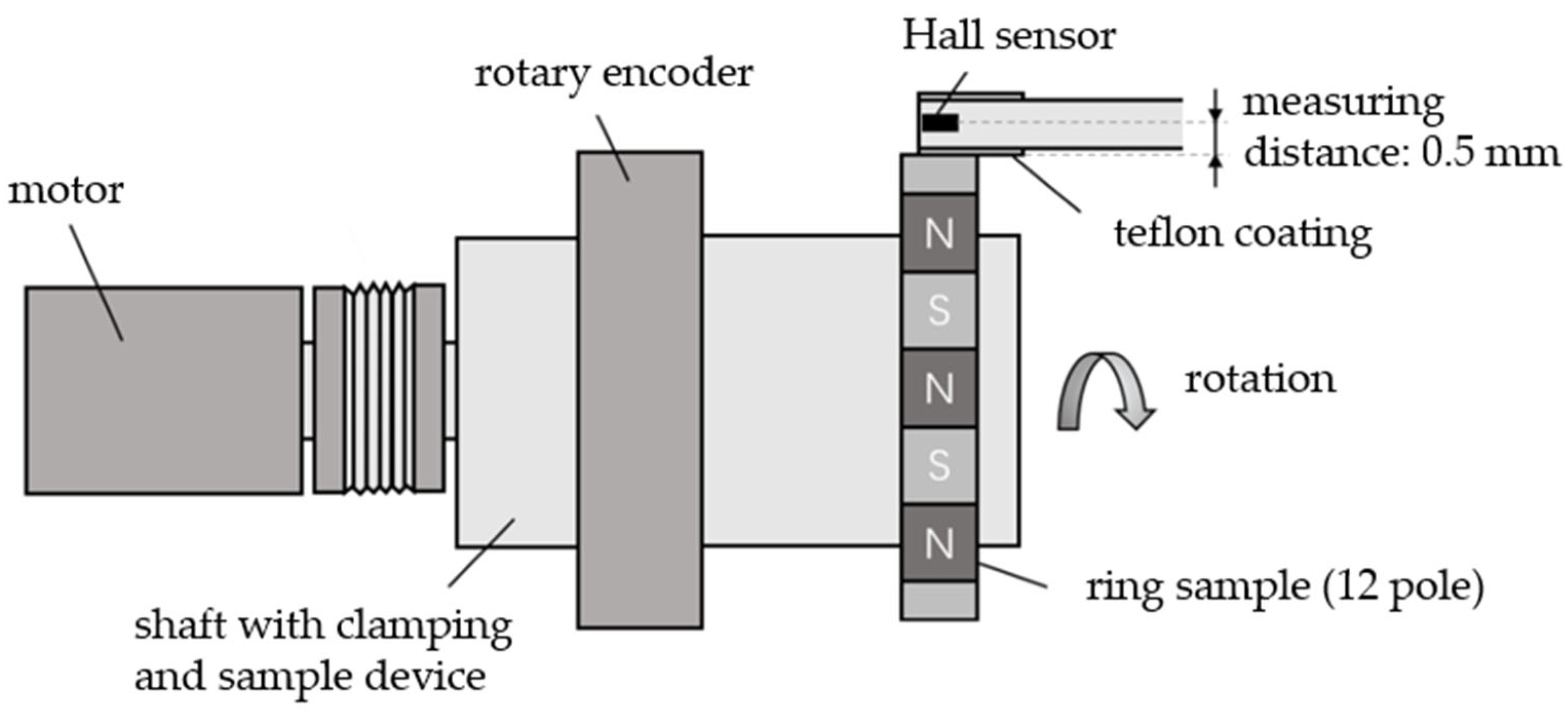
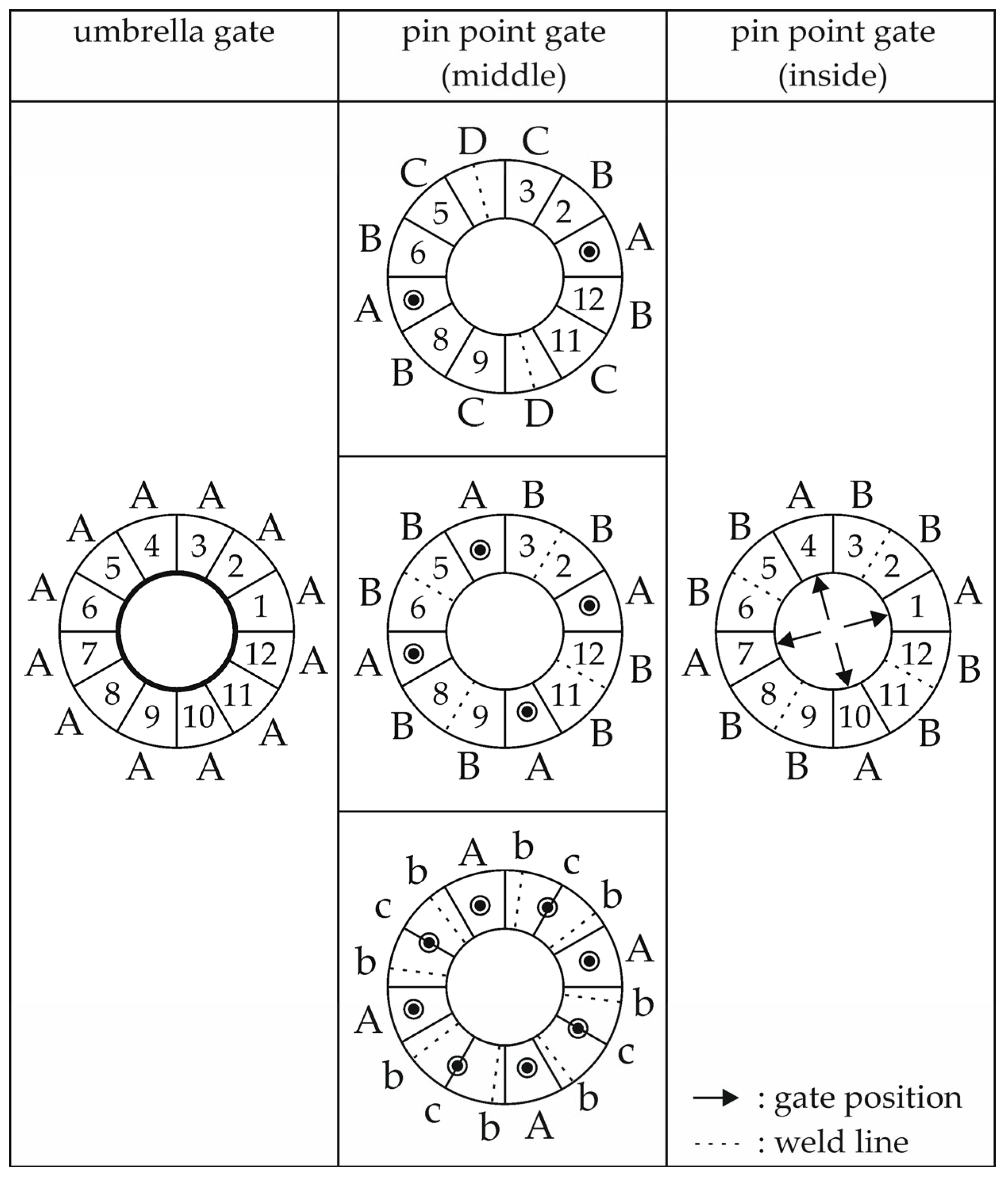



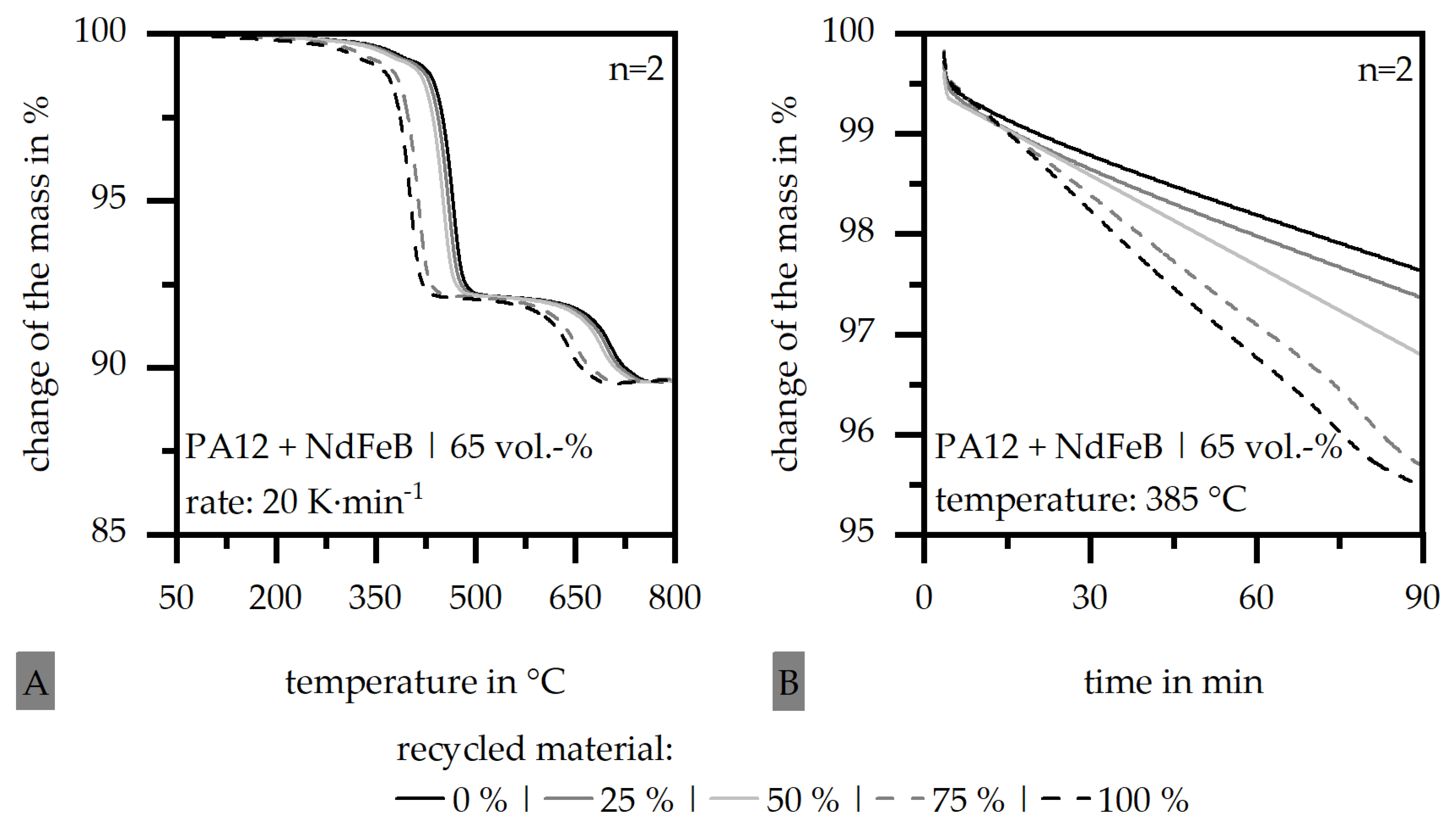
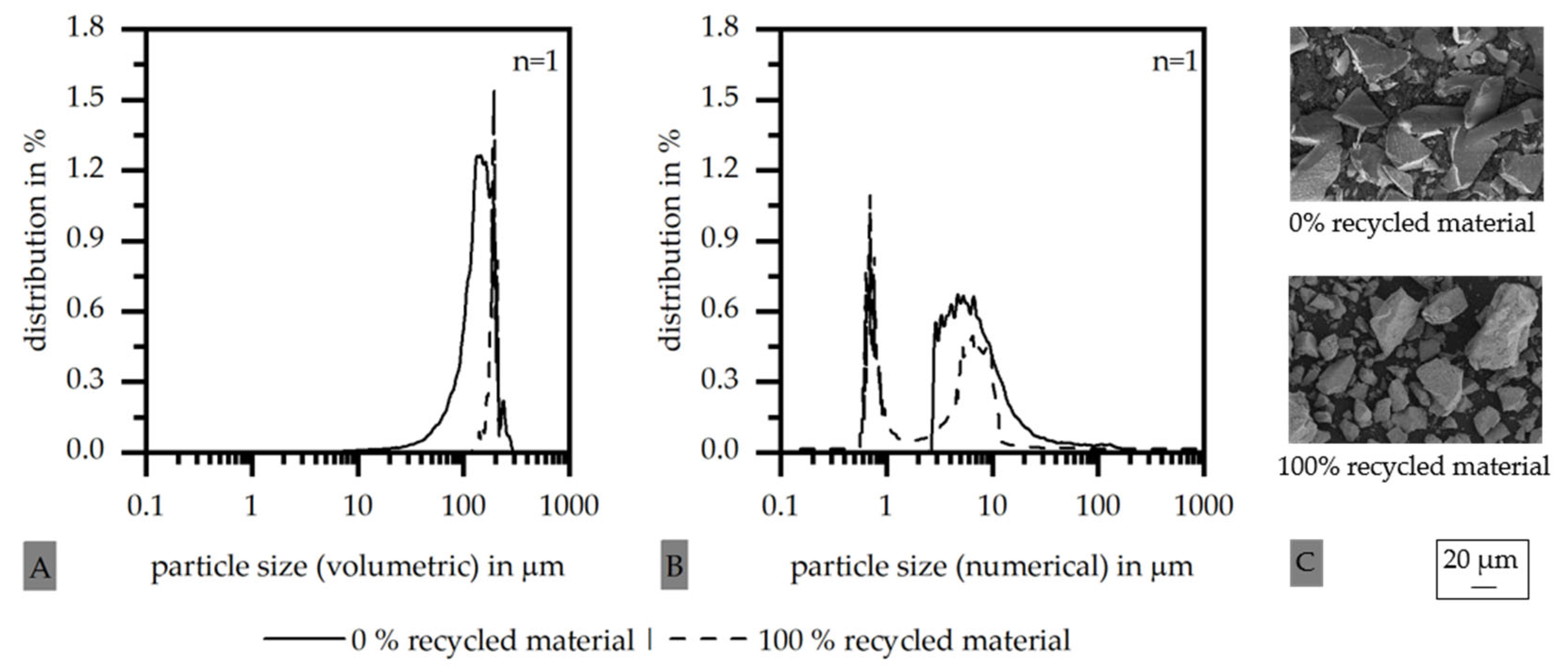
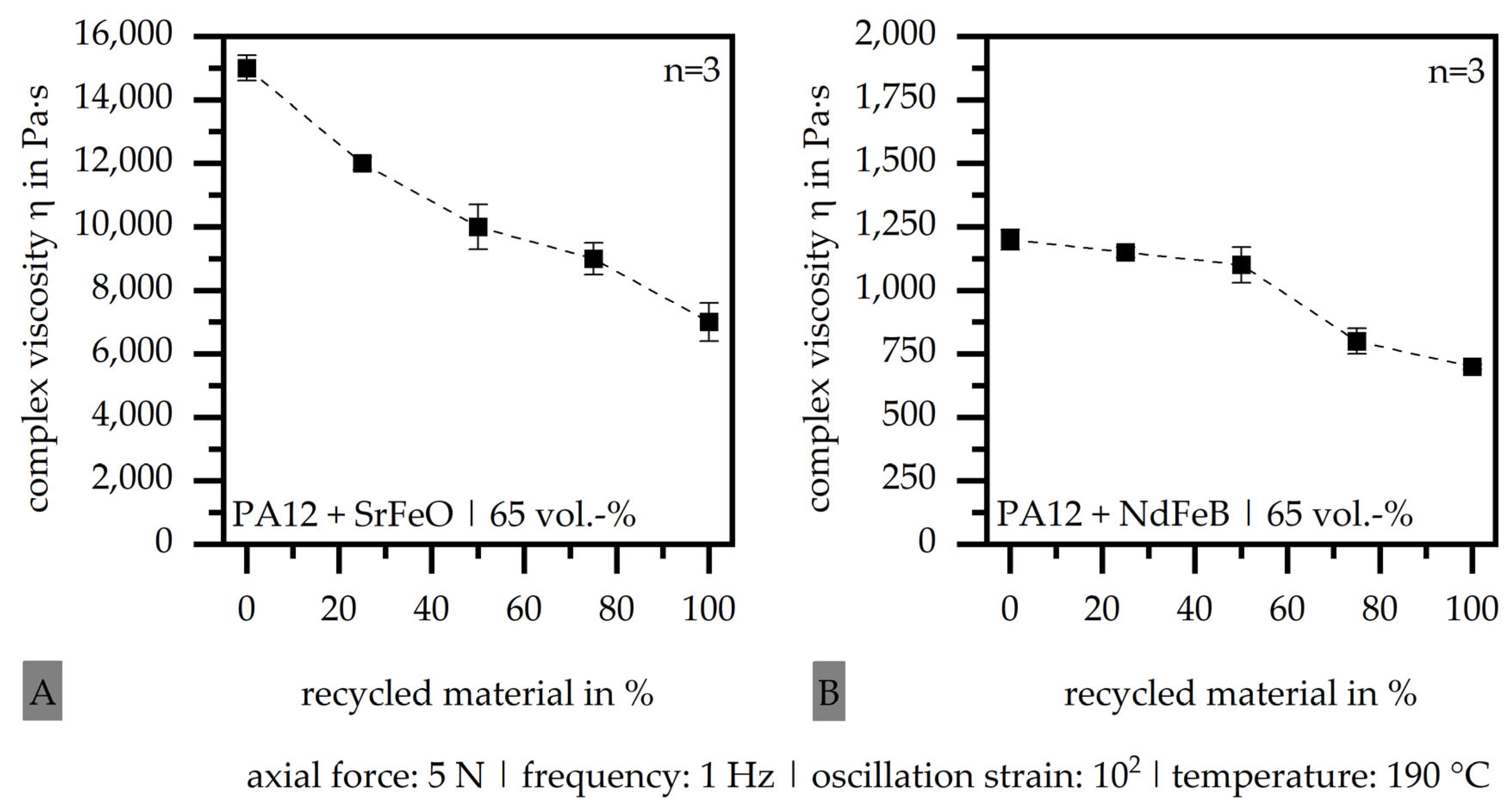

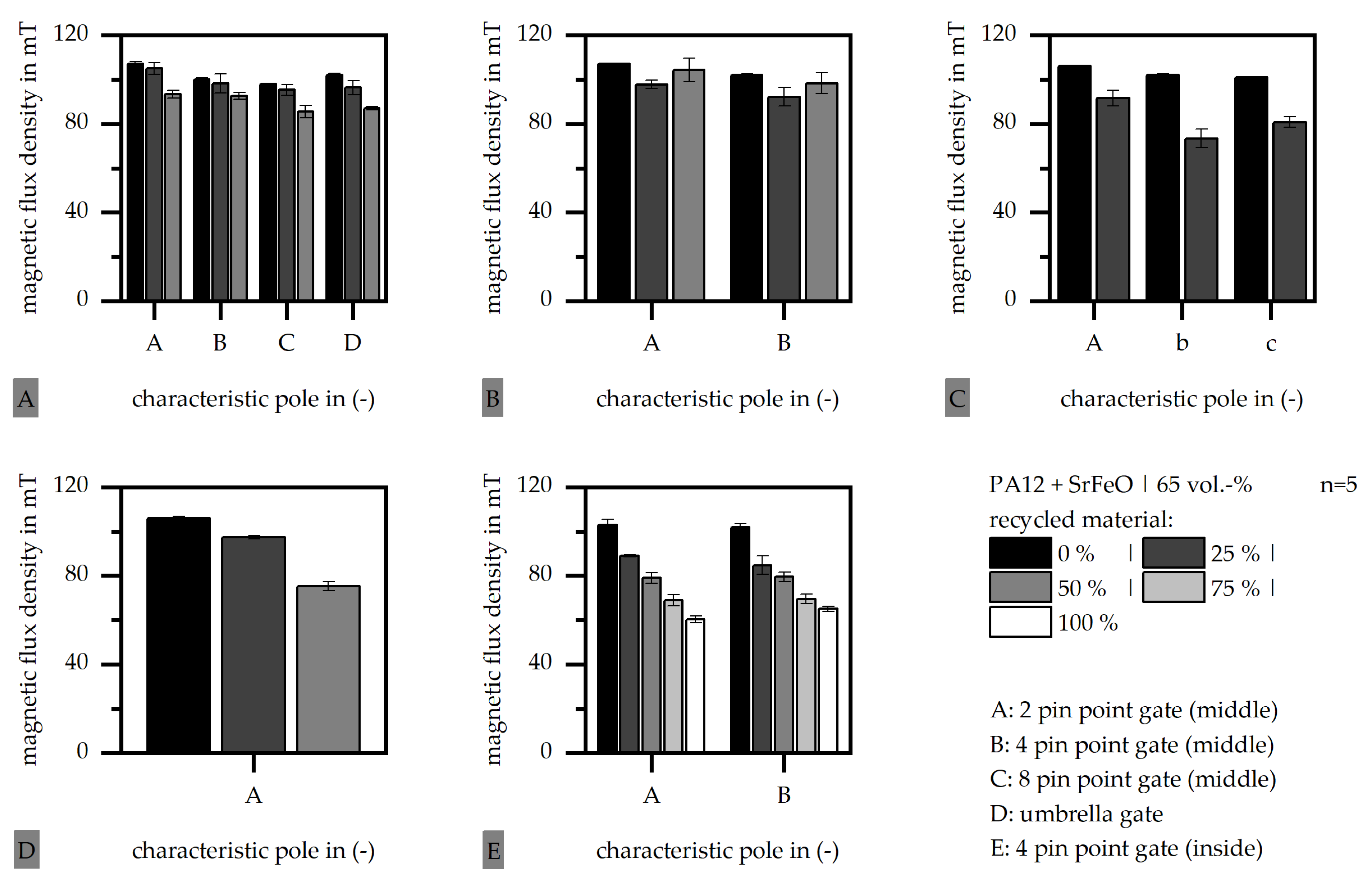

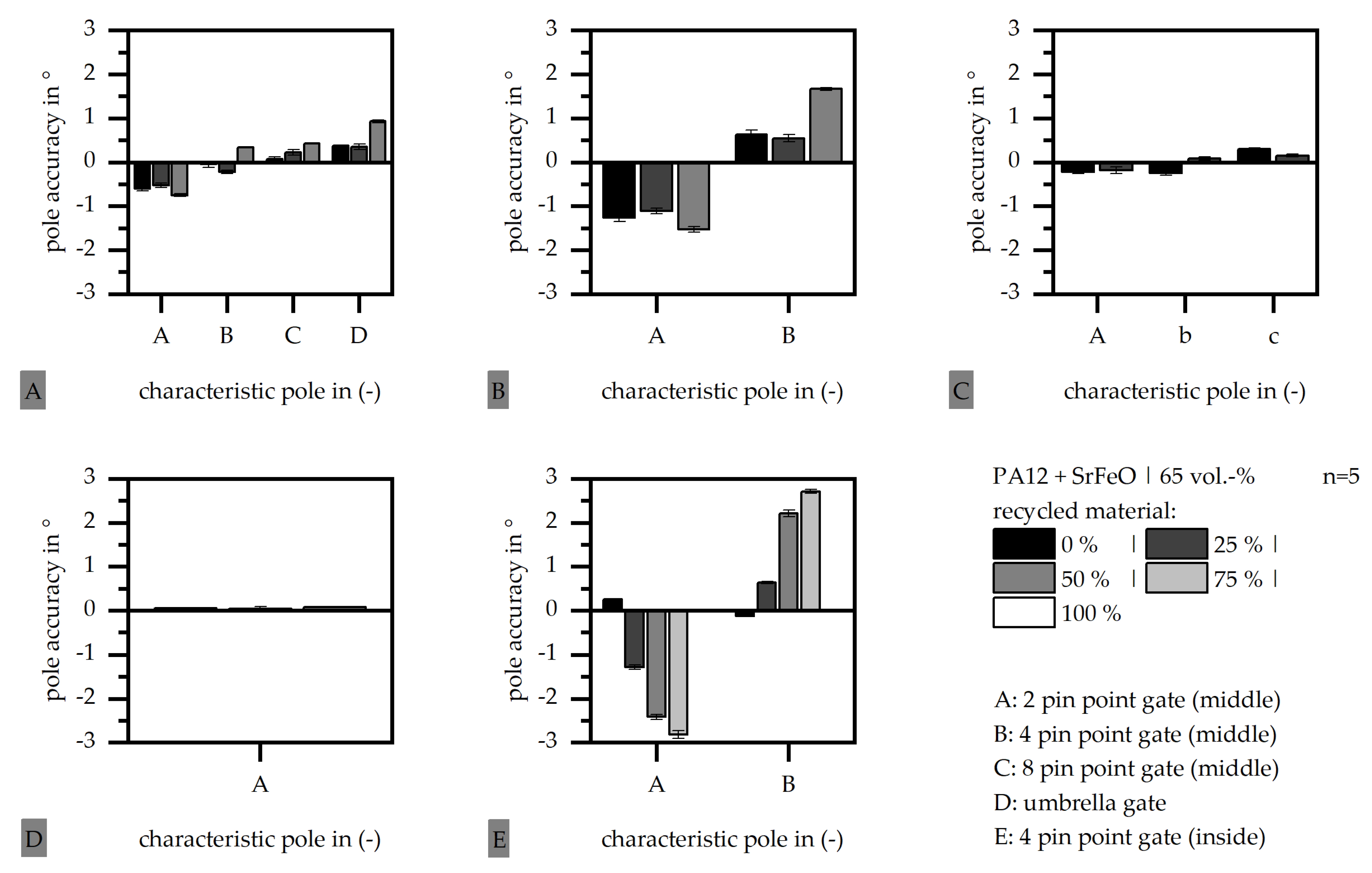
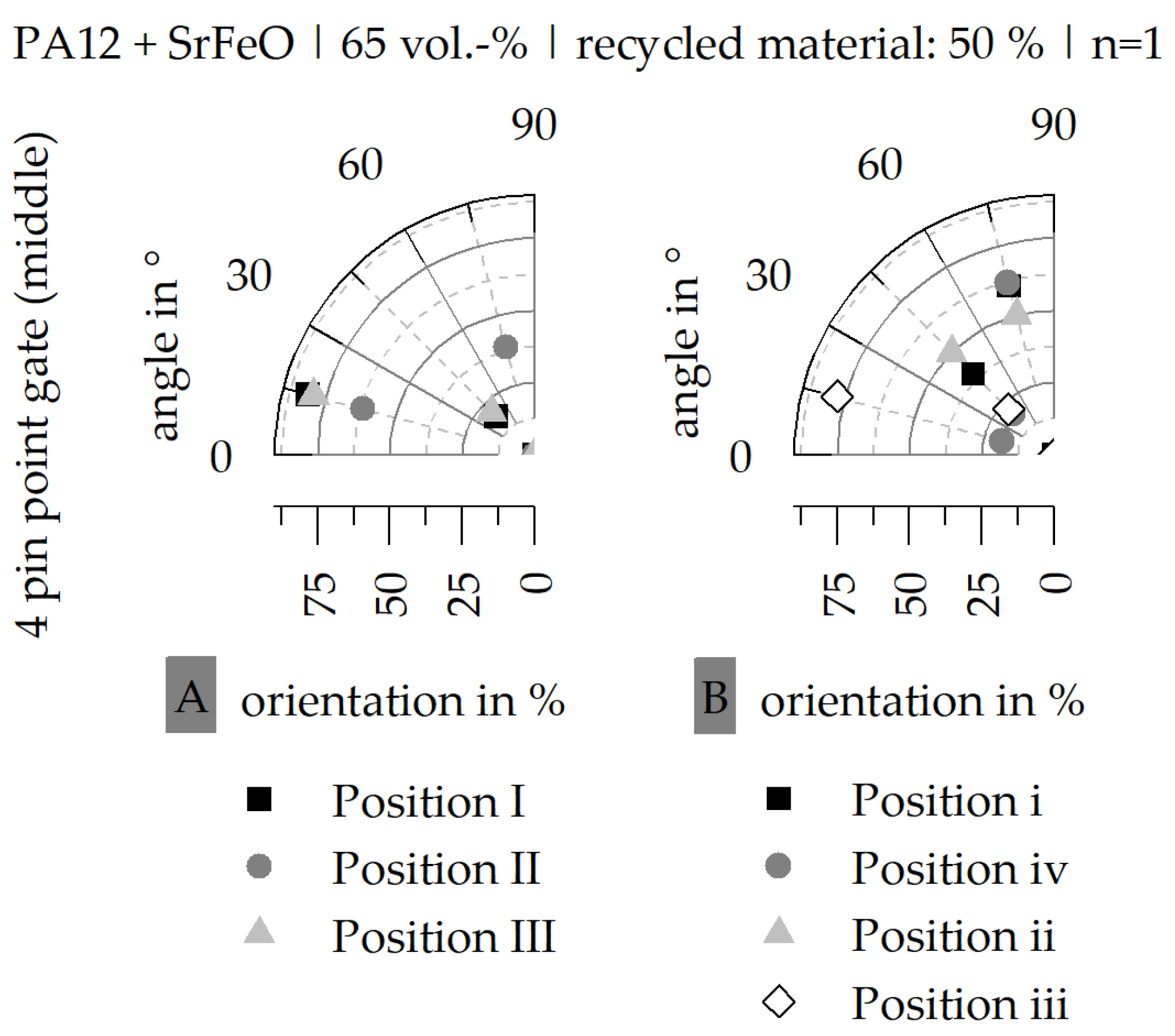

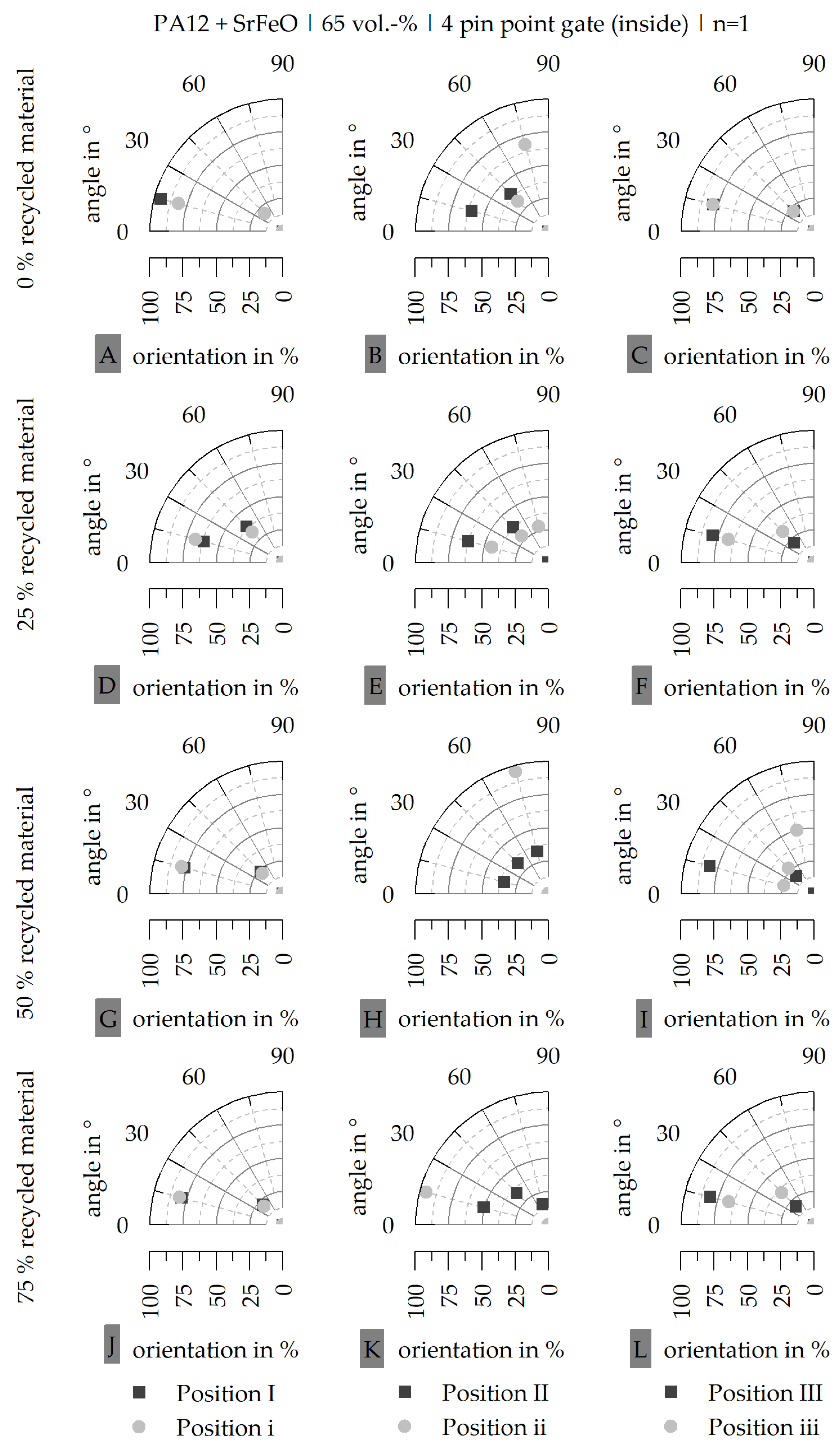
| Commercial Material | Type | Recycled Material in % | Density in g∙cm−3 | Remanence BR in mT |
|---|---|---|---|---|
| PA12 with SrFeO | HM-1222H | 0|25|50|75|100 | 3.85 | 313 |
| PA12 with NdFeB | RNI-25LF2 | 0|25|50|75|100 | 4.01 | 338 |
| Mass temperature | 280 °C |
| Mold temperature | 80 °C |
| Injection speed | 80 mm/s |
| Changeover point | 1000–2400 bar |
| Holding pressure | 500 bar |
| Gating System | 2 Pin Point (Middle) | 4 Pin Point (Middle) | 8 Pin Point (Middle) | Umbrella | 4 Pin Point (Inside) |
|---|---|---|---|---|---|
| Amount of Recycled Material in % | - | - | - | - | - |
| 0 | yes | yes | yes | yes | yes |
| 25 | yes | yes | yes | yes | yes |
| 50 | yes | yes | no | yes | yes |
| 75 | no | no | no | no | yes |
| 100 | no | no | no | no | yes |
| Gating System | 2 Pin Point (Middle) | 4 Pin Point (Middle) | 8 Pin Point (Middle) | Umbrella | 4 Pin Point (Inside) |
|---|---|---|---|---|---|
| Amount of Recycled Material in % | - | - | - | - | - |
| A|B | A|B | A|B | A|B | A|B | |
| 25 | yes|yes | yes|yes | no|no | yes|yes | no|yes |
| 50 | no|yes | no|yes | - | no|no | no|no |
| 75 | - | - | - | - | no|no |
| 100 | - | - | - | - | no|no |
| Gating System | 2 Pin Point (Middle) | 4 Pin Point (Middle) | 8 Pin Point (Middle) | Umbrella | 4 Pin Point (Inside) |
|---|---|---|---|---|---|
| Amount of Recycled Material in % | - | - | - | - | - |
| A|B | A|B | A|B | A|B | A|B | |
| 25 | yes|yes | no|yes | no|no | no|no | no|yes |
| 50 | no|no | no|yes | - | no|no | no|no |
| 75 | - | - | - | - | no|no |
| 100 | - | - | - | - | no|no |
| Gating System | 2 Pin Point (Middle) | 4 Pin Point (Middle) | 8 Pin Point (Middle) | Umbrella | 4 Pin Point (Inside) |
|---|---|---|---|---|---|
| Amount of Recycled Material in % | - | - | - | - | - |
| A|B | A|B | A|B | A|B | A|B | |
| 25 | yes|yes | yes|yes | no|no | yes|yes | no|no |
| 50 | no|yes | no|no | - | no|no | no|no |
| 75 | - | - | - | - | no|no |
| 100 | - | - | - | - | no|no |
| Gating System | 2 Pin Point (Middle) | 4 Pin Point (Middle) | 8 Pin Point (Middle) | Umbrella | 4 Pin Point (Inside) |
|---|---|---|---|---|---|
| Amount of Recycled Material in % | - | - | - | - | - |
| A|B | A|B | A|B | A|B | A|B | |
| 25 | yes|yes | no|yes | no|no | no|no | no|no |
| 50 | no|no | no|no | - | no|no | no|no |
| 75 | - | - | - | - | no|no |
| 100 | - | - | - | - | no|no |
Disclaimer/Publisher’s Note: The statements, opinions and data contained in all publications are solely those of the individual author(s) and contributor(s) and not of MDPI and/or the editor(s). MDPI and/or the editor(s) disclaim responsibility for any injury to people or property resulting from any ideas, methods, instructions or products referred to in the content. |
© 2024 by the authors. Licensee MDPI, Basel, Switzerland. This article is an open access article distributed under the terms and conditions of the Creative Commons Attribution (CC BY) license (https://creativecommons.org/licenses/by/4.0/).
Share and Cite
Rösel, U.; Drummer, D. Changes in Material Behavior according to the Amount of Recycled Magnetic Materials in Polymer-Bonded Magnets Based on Thermoplastics. Magnetism 2024, 4, 1-23. https://doi.org/10.3390/magnetism4010001
Rösel U, Drummer D. Changes in Material Behavior according to the Amount of Recycled Magnetic Materials in Polymer-Bonded Magnets Based on Thermoplastics. Magnetism. 2024; 4(1):1-23. https://doi.org/10.3390/magnetism4010001
Chicago/Turabian StyleRösel, Uta, and Dietmar Drummer. 2024. "Changes in Material Behavior according to the Amount of Recycled Magnetic Materials in Polymer-Bonded Magnets Based on Thermoplastics" Magnetism 4, no. 1: 1-23. https://doi.org/10.3390/magnetism4010001





